The Parasomnia Treatment Market is estimated to be valued at USD 343.1 million in 2025 and is projected to reach USD 569.6 million by 2035, registering a compound annual growth rate (CAGR) of 5.2% over the forecast period.
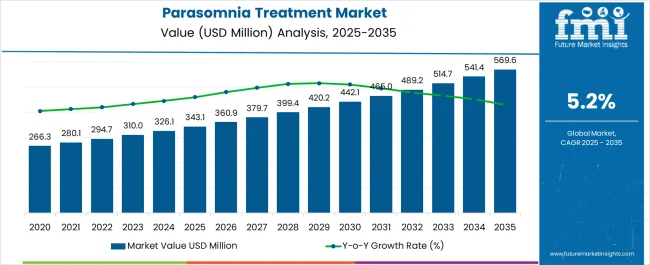
| Metric | Value |
|---|---|
| Parasomnia Treatment Market Estimated Value in (2025 E) | USD 343.1 million |
| Parasomnia Treatment Market Forecast Value in (2035 F) | USD 569.6 million |
| Forecast CAGR (2025 to 2035) | 5.2% |
The Parasomnia Treatment market is witnessing steady growth as awareness about sleep disorders increases and diagnostic capabilities improve. The current market scenario is shaped by the rising prevalence of parasomnia, particularly among adults with stress-related sleep disturbances and underlying neurological conditions. Increasing investments in healthcare infrastructure and the availability of specialized sleep clinics have contributed to expanding treatment adoption.
Advancements in pharmacological therapies, including targeted medication for different parasomnia subtypes, have improved patient outcomes and treatment compliance. Additionally, the growing focus on personalized medicine and patient-specific treatment plans has enhanced the effectiveness of interventions.
As healthcare providers continue to integrate sleep disorder management into broader wellness programs, opportunities for both pharmaceutical and healthcare distribution channels are increasing The demand for accessible and effective treatments, combined with an aging population and rising incidence of sleep disturbances, positions the Parasomnia Treatment market for continued expansion, with new therapeutic approaches and improved patient monitoring expected to drive future growth.
The parasomnia treatment market is segmented by type, treatment type, distribution channel, and geographic regions. By type, parasomnia treatment market is divided into Non-Rapid Eye Movement (NREM) Related Parasomnia, Rapid Eye Movement (REM) Related Parasomnia, and Other Parasomnia. In terms of treatment type, parasomnia treatment market is classified into Benzodiazepines, Anticonvulsants, and Antidepressants. Based on distribution channel, parasomnia treatment market is segmented into Hospitals Pharmacies, Retail Stores, Drug Stores, and E-Commerce. Regionally, the parasomnia treatment industry is classified into North America, Latin America, Western Europe, Eastern Europe, Balkan & Baltic Countries, Russia & Belarus, Central Asia, East Asia, South Asia & Pacific, and the Middle East & Africa.
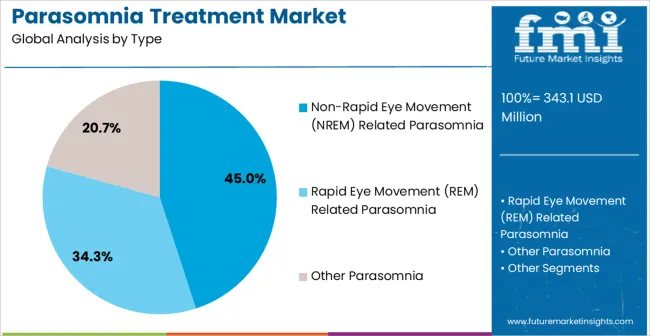
The Non-Rapid Eye Movement Related Parasomnia segment is expected to hold 45.0% of the Parasomnia Treatment market revenue share in 2025, making it the leading type segment. This dominance is attributed to the high prevalence of NREM-related sleep disorders, such as sleepwalking and sleep terrors, which require specialized interventions.
Growth has been supported by improved diagnostic techniques and the development of targeted treatment protocols that address the underlying neurological and behavioral triggers. The segment’s expansion has also been facilitated by heightened awareness among healthcare providers and patients, enabling early intervention and better management of symptoms.
As treatments are increasingly personalized, patient adherence improves, further supporting revenue growth The ability to integrate pharmacological therapy with behavioral and cognitive approaches has reinforced the segment’s market leadership, ensuring sustained demand in both inpatient and outpatient care settings.
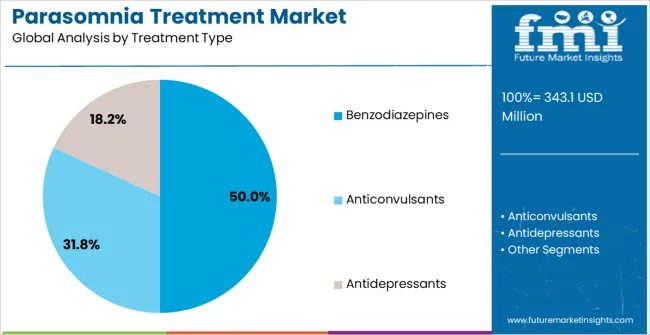
The Benzodiazepines treatment segment is projected to capture 50.0% of the overall Parasomnia Treatment market revenue in 2025, emerging as the dominant pharmacological approach. This leadership is attributed to the drug class’s effectiveness in reducing sleep disruptions and managing severe NREM parasomnia episodes. Growth has been reinforced by their well-established safety profile when administered under medical supervision and the ability to address multiple parasomnia symptoms simultaneously.
The segment benefits from widespread clinical acceptance and proven efficacy, which enhance patient and physician confidence in treatment outcomes. Additionally, ongoing improvements in dosing regimens and formulation options have optimized therapeutic benefits while minimizing side effects.
The increasing availability of benzodiazepines through healthcare providers and pharmacies has facilitated patient access, ensuring broad market adoption As clinical guidelines continue to emphasize targeted pharmacological interventions, the Benzodiazepines segment is expected to maintain its leadership in the Parasomnia Treatment market.
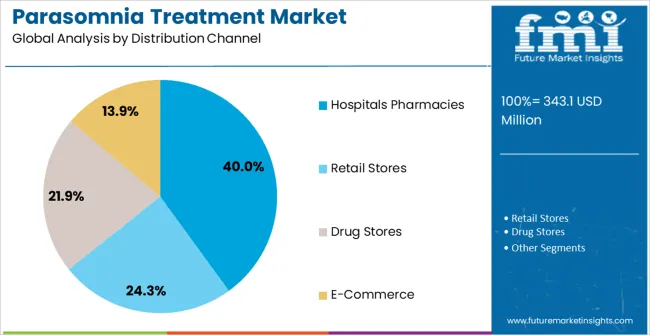
The Hospitals Pharmacies distribution channel segment is anticipated to hold 40.0% of the Parasomnia Treatment market revenue in 2025, positioning it as the leading channel for treatment delivery. Growth in this segment is being driven by the central role hospitals and pharmacies play in patient access to prescription medications and ongoing management of parasomnia.
These channels provide reliable availability of therapies, professional guidance, and integrated patient care, which enhance treatment adherence and outcomes. The expansion of hospital networks and pharmacy chains has further enabled widespread distribution, ensuring medications are accessible across urban and semi-urban regions.
Additionally, the integration of clinical counseling and follow-up services with medication provision has reinforced patient trust and utilization As healthcare providers increasingly emphasize structured sleep disorder management programs, the Hospitals Pharmacies channel is expected to sustain leadership, offering both convenience and continuity of care to patients seeking effective parasomnia treatments.
Parasomnia is a sleep disorder in which unwanted events occur while the patient is in sleep. It includes abnormal movements, behaviors or dreams. Also, it becomes difficult to sleep at night. The patient will have no memory of what has occurred.
Parasomnia occurs in combination with sleep or stages of sleep. It includes various activities such as sleep-walking, sleep terrors, confusional arousals, sleep eating disorders, sleep paralysis, nightmares, sleep hallucinations, bed walking and sleep talking.
Parasomnia treatments include medications, exercise, and therapies. Almost 18% of the population is affected by sleepwalking. The disease parasomnia is more common in children of 11 to 12 years of age than in adolescents and adults.
Also, boys are expected to suffer more than the girls. However, it can occur due to genetic tendency also. The disease is prevailing between the ages 8 to 12 year but can continue into adulthood. Also, good sleep routines and avoiding sleep deprivation will help in reducing the prevalence of events and help in parasomnia treatment.
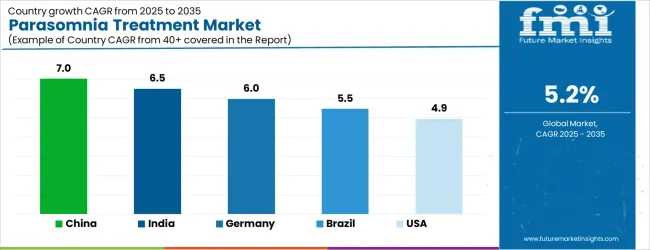
| Country | CAGR |
|---|---|
| China | 7.0% |
| India | 6.5% |
| Germany | 6.0% |
| Brazil | 5.5% |
| USA | 4.9% |
| UK | 4.4% |
| Japan | 3.9% |
The Parasomnia Treatment Market is expected to register a CAGR of 5.2% during the forecast period, exhibiting varied country level momentum. China leads with the highest CAGR of 7.0%, followed by India at 6.5%. Developed markets such as Germany, France, and the UK continue to expand steadily, while the USA is likely to grow at consistent rates. Japan posts the lowest CAGR at 3.9%, yet still underscores a broadly positive trajectory for the global Parasomnia Treatment Market. In 2024, Germany held a dominant revenue in the Western Europe market and is expected to grow with a CAGR of 6.0%. The USA Parasomnia Treatment Market is estimated to be valued at USD 121.5 million in 2025 and is anticipated to reach a valuation of USD 121.5 million by 2035. Sales are projected to rise at a CAGR of 0.0% over the forecast period between 2025 and 2035. While Japan and South Korea markets are estimated to be valued at USD 17.7 million and USD 11.1 million respectively in 2025.
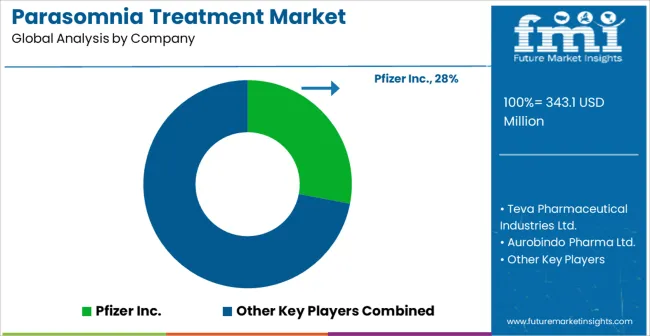
| Item | Value |
|---|---|
| Quantitative Units | USD 343.1 Million |
| Type | Non-Rapid Eye Movement (NREM) Related Parasomnia, Rapid Eye Movement (REM) Related Parasomnia, and Other Parasomnia |
| Treatment Type | Benzodiazepines, Anticonvulsants, and Antidepressants |
| Distribution Channel | Hospitals Pharmacies, Retail Stores, Drug Stores, and E-Commerce |
| Regions Covered | North America, Europe, Asia-Pacific, Latin America, Middle East & Africa |
| Country Covered | United States, Canada, Germany, France, United Kingdom, China, Japan, India, Brazil, South Africa |
| Key Companies Profiled | Pfizer Inc., Teva Pharmaceutical Industries Ltd., Aurobindo Pharma Ltd., Sun Pharmaceutical Industries Ltd., Torrent Pharmaceuticals Ltd., Cadila Pharmaceuticals, Intas Pharmaceuticals Ltd., and Sandoz International GmbH |
The global parasomnia treatment market is estimated to be valued at USD 343.1 million in 2025.
The market size for the parasomnia treatment market is projected to reach USD 569.6 million by 2035.
The parasomnia treatment market is expected to grow at a 5.2% CAGR between 2025 and 2035.
The key product types in parasomnia treatment market are non-rapid eye movement (nrem) related parasomnia, rapid eye movement (rem) related parasomnia and other parasomnia.
In terms of treatment type, benzodiazepines segment to command 50.0% share in the parasomnia treatment market in 2025.






Our Research Products

The "Full Research Suite" delivers actionable market intel, deep dives on markets or technologies, so clients act faster, cut risk, and unlock growth.

The Leaderboard benchmarks and ranks top vendors, classifying them as Established Leaders, Leading Challengers, or Disruptors & Challengers.

Locates where complements amplify value and substitutes erode it, forecasting net impact by horizon

We deliver granular, decision-grade intel: market sizing, 5-year forecasts, pricing, adoption, usage, revenue, and operational KPIs—plus competitor tracking, regulation, and value chains—across 60 countries broadly.

Spot the shifts before they hit your P&L. We track inflection points, adoption curves, pricing moves, and ecosystem plays to show where demand is heading, why it is changing, and what to do next across high-growth markets and disruptive tech

Real-time reads of user behavior. We track shifting priorities, perceptions of today’s and next-gen services, and provider experience, then pace how fast tech moves from trial to adoption, blending buyer, consumer, and channel inputs with social signals (#WhySwitch, #UX).

Partner with our analyst team to build a custom report designed around your business priorities. From analysing market trends to assessing competitors or crafting bespoke datasets, we tailor insights to your needs.
Supplier Intelligence
Discovery & Profiling
Capacity & Footprint
Performance & Risk
Compliance & Governance
Commercial Readiness
Who Supplies Whom
Scorecards & Shortlists
Playbooks & Docs
Category Intelligence
Definition & Scope
Demand & Use Cases
Cost Drivers
Market Structure
Supply Chain Map
Trade & Policy
Operating Norms
Deliverables
Buyer Intelligence
Account Basics
Spend & Scope
Procurement Model
Vendor Requirements
Terms & Policies
Entry Strategy
Pain Points & Triggers
Outputs
Pricing Analysis
Benchmarks
Trends
Should-Cost
Indexation
Landed Cost
Commercial Terms
Deliverables
Brand Analysis
Positioning & Value Prop
Share & Presence
Customer Evidence
Go-to-Market
Digital & Reputation
Compliance & Trust
KPIs & Gaps
Outputs
Full Research Suite comprises of:
Market outlook & trends analysis
Interviews & case studies
Strategic recommendations
Vendor profiles & capabilities analysis
5-year forecasts
8 regions and 60+ country-level data splits
Market segment data splits
12 months of continuous data updates
DELIVERED AS:
PDF EXCEL ONLINE
Treatment-Resistant Hypertension Management Market Size and Share Forecast Outlook 2025 to 2035
Treatment-Resistant Depression Treatment Market Size and Share Forecast Outlook 2025 to 2035
Treatment Pumps Market Insights Growth & Demand Forecast 2025 to 2035
Pretreatment Coatings Market Size and Share Forecast Outlook 2025 to 2035
Air Treatment Ozone Generator Market Size and Share Forecast Outlook 2025 to 2035
CNS Treatment and Therapy Market Insights - Trends & Growth Forecast 2025 to 2035
Seed Treatment Materials Market Size and Share Forecast Outlook 2025 to 2035
Acne Treatment Solutions Market Size and Share Forecast Outlook 2025 to 2035
Scar Treatment Market Overview - Growth & Demand Forecast 2025 to 2035
Soil Treatment Chemicals Market
Water Treatment System Market Size and Share Forecast Outlook 2025 to 2035
Water Treatment Chemical Market Size and Share Forecast Outlook 2025 to 2035
Algae Treatment Chemical Market Forecast and Outlook 2025 to 2035
Water Treatment Market Size and Share Forecast Outlook 2025 to 2035
Water Treatment Ozone Generator Market Size and Share Forecast Outlook 2025 to 2035
Water Treatment Equipment Market Size and Share Forecast Outlook 2025 to 2035
Burns Treatment Market Overview – Growth, Demand & Forecast 2025 to 2035
CRBSI Treatment Market Insights - Growth, Trends & Forecast 2025 to 2035
Water Treatment Polymers Market Growth & Demand 2025 to 2035
Asthma Treatment Market Forecast and Outlook 2025 to 2035

Thank you!
You will receive an email from our Business Development Manager. Please be sure to check your SPAM/JUNK folder too.
Chat With
MaRIA